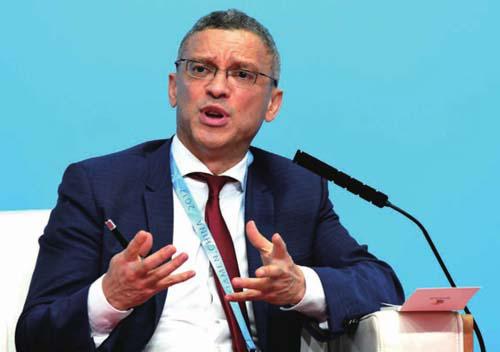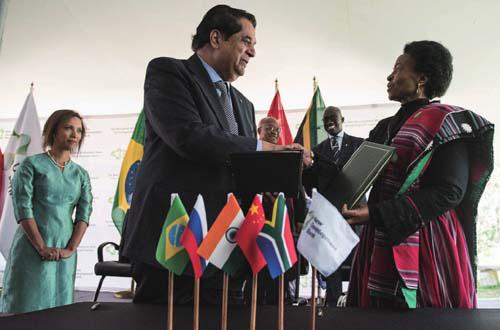BANKING ON SUCCESS
2018-08-16
As one of the major supporting facilities of the BRICS cooperation mechanism, the New Development Bank (NDB) formally came into existence as a legal entity in 2015 to provide much needed funding for infrastructure development. Beijing Review spoke with Leslie Maasdorp, Vice President and Chief Financial Officer of the NDB, headquartered in Shanghai, China, to find out more about the banks operation and its future plans. An edited excerpt of his views follows:
Beijing Review: What is the role of the NDB in the BRICS group?
Leslie Maasdorp: The NDB was established to finance long-term infrastructure, especially sustainable infrastructure, in Brazil, Russia, India, China and South Africa. There is a huge need to finance the building of ports, roads and railways, and power all kinds of big infrastructure so as to continue the process of industrialization and growth of these economies. All of the BRICS economies are emerging markets and in need of some new economic infrastructure. There is a huge financing gap in the building of this infrastructure.
There are existing financial institutions that also finance infrastructure construction. We were started by these five countries to complement and be an additional resource to help them with infrastructure roll-out.
What achievements has the NDB made to date?
The bank was started in July 2015. Since then, we have completed loans to the tune of $5.1 billion. These loans are for projects in all of the sectors that Ive mentioned: ports, airports and railways, with a strong focus on renewable energy and some focus on water and urban infrastructure. So the bank has, in a very short period of time, established itself and has 120 professionals working for the institution. We have completed about 16 projects in the five countries.
How does the NDB create a balance of funding among its member countries?
Firstly, the bank is unique in the sense that it is owned in equal shareholding by the five BRICS countries; so each country holds 20 percent of the shares. Each of the five countries put in $2 billion of equity, and we have also whats referred to as callable capital of$40 billion. So the total subscribed capital base of the bank is $50 billion. The bank is focused on a model of equal participation by the five members. So the five countries are also represented equally in the form of top management. Each country has one representative; therefore, no country has veto power in the bank or controls the bank. It is run equally by the BRICS countries.
How does the NDB work in harmony with other international financial institutions?
The NDB was created as a voice of emerging markets. All of the five BRICS members are developing countries; however we definitely work in a complementary fashion with other financial institutions like the World Bank, the Asian Development Bank (ADB) and the African Development Bank. The reason for this is the large demand for infrastructure funding.
The amount of infrastructure funding needed to build all the new roads, ports, airports and power stations required is very large. Each of these banks contributes to that effort and there is still a massive funding gap. So there is no real competition among these banks. We are all owned by the government, so we therefore have a public policy mandate. We all focus on financing infrastructure.
In fact, we are working right now on projects where we cooperate directly with the World Bank and the ADB, and we are funding these projects together. What is unique about the NDB is that our focus is much more on the demand and the needs of developing countries and emerging markets.
What innovative approaches to development will the NDB pursue?
First, as I have already mentioned, the overwhelming majority of our projects are focusing on sustainability. So whatever we do, we are going to build it in such a way that we are focusing on the long-term needs of the five countries and on how to reduce carbon emissions in these economies. We will contribute to clean and green energy in these countries. So thats the first differentiator.
Second, we want to level off new technology, since there have been significant technological advances in the way infrastructure is built today. The kind of world we live in 20 or 30 years from now is going to be very different from the world we live in today. So we are trying to look at all the ways in which we can use the best that technology has to offer.
The third aspect of importance in innovative approaches is that in the past, multilateral banks mainly advanced loans in U.S. dollars; we will also lend to countries in their local currencies, which then enables the countries to avoid foreign exchange risks. The bank will also pursue local currency financing, which is a form of innovation too.
Fourth, we will also look at new forms of financing with the private sector. The bank will not only lend to the government and state-run enterprises, but will also lend to the private sector to bring in more private sources of capital to finance these projects.
In what way can the NDB be of help to Africas development as a whole?
First, the bank is focused on lending mainly to the BRICS countries; so in Africa, South Africa is the only member country for now. However, we will put specific emphasis on projects that advance and enhance regional connectivity and integration. In South Africa, we will look at projects that can benefit the region. Thats the first way the African continent will benefit.
The second way is that the bank will open up its membership to new countries to join in the next year or so, and we anticipate that other African countries will join the bank and then be able to directly apply for loans. The reason why countries will be quite interested is the cost of capital or the interest rates for loans will be very competitive. We will be able to give better rates compared to what they get from commercial banks. So we will be able to help the advancement and development of Africa by granting loans for infrastructure construction in these countries.
